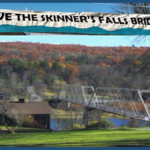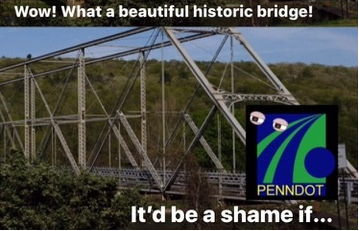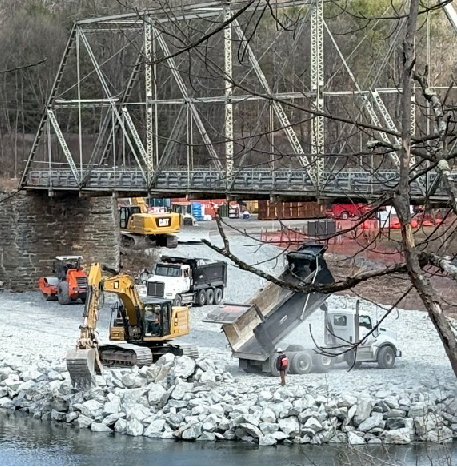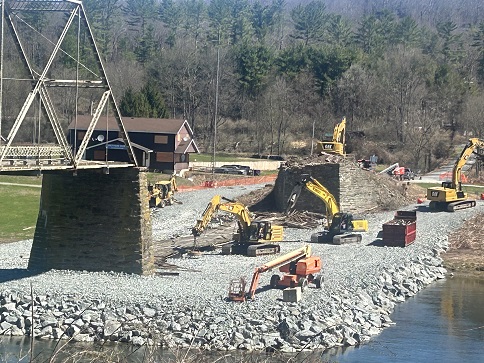
DCS Seeks Injunction Against the Demolition of the Skinners Falls Bridge
April 8, 2025
Skinners Falls Bridge Injunction Denied
April 16, 2025Skinners Falls Bridge Goes to Federal Court

Construction activity underneath a bridge PennDOT claims could collapse anytime, 3-31-25. Photo by Jeff Dexter
For immediate release
Contact: rosebiondi2@gmail.com
SKINNERS FALLS BRIDGE GOES TO FEDERAL COURT
(Scranton, PA) On Friday, April 10, 2025 the future of historic Skinners Falls Bridge was the matter brought before Judge J. Mehalchick at the U.S. District Court for the Middle District of Pennsylvania in Scranton, Pennsylvania. The official title of the lawsuit is Damascus Citizens for Sustainability, Inc. et al v. Duffy et al. https://www.damascuscitizensforsustainability.org/2025/04/08/dcs-seeks-injunction-against-the-demolition-of-the-skinners-falls-bridge/ Proceedings commenced at 9 AM and closed at 3:30 PM. The judge will make her decision sometime in the next 14 days. Meanwhile, the restraining order on the demolition of the 124 year old landmark is in place.
Damascus Citizens for Sustainability (DCS) as plaintiff is represented by Andrea Ferster and Michael Fiorentino. The defendants, including Pennsylvania Department of Transportation (PennDOT) and the Federal Highway Administration (FHWA), were represented by Neal T. Brofee and Richard Euliss, an assistant attorney for the U.S. Middle District of Pennsylvania. Ms. Ferster and Mr. Fiorentino have extensive background in successfully representing environmental causes, including historic preservation. The National Trust For Historic Preservation, Preservation Pennsylvania and The JM Kaplan Fund were instrumental in assisting DCS in finding counsel to file an emergency restraining order halting demolition of the bridge which is listed on the National Register of Historic Places in two categories. Some of the key points of their argument can be read in the document following this media advisory.*
The substance of the defendants’ argument was the safety of the public superseded federal laws. Implicit in their argument was that DCS has no concern for the health and safety of the public. DCS’s two decades of advocacy for the preservation of public health and the environment is evidence that this is wrong. In the course of the proceedings, the defendants failed to respond to key elements of the lawsuit.
PennDOT’s three witnesses testified that the bridge is in imminent danger of collapse and a serious safety threat to anyone who comes near it. This is the basis of an emergency statement they solicited from Pennsylvania Governor Josh Shapiro on December 16, 2024. One witness, Ezequiel “Zack” Lujan, P.E., had never traveled to the site and only based his testimony on photographs and measurements made by others with a wood folding ruler. Daniel Radle, P.E., of AECOM, also said the bridge could fall suddenly and without warning. Mr. Radle’s testimony is negated by AECOM’s own documents. This is clear on page 33 of HBRA Phase One Analysis which can be reviewed at this link: AEcom’s own documentation- Page 33 of link. Mr. Radle has no training or experience in historic bridge restoration.
DCS’s requests to PennDOT to access the bridge for purposes of an independent engineering evaluation have never been acknowledged. PennDOT has also not provided DCS access to its un-redacted engineering reports. DCS has consulted extensively with registered architects and engineers, who are specialists in historic preservation all of whom claim the bridge is restorable.
They include Art Suckewer, owner of Wrought Iron Bridge Works (WIBW) who states:
“I agree with PennDOT’s own consultants that the bridge is in need of stabilization followed by a true restoration and is not beyond salvage. This bridge is fully restorable and, once restored, it will be adequate for this crossing.
I am of the opinion that it is unfair and unreasonable to put PennDOT in the role of historic preservation. PennDOT, like most DOTs, is tasked with maintaining and upgrading transportation infrastructure to the latest modern standards. It is unreasonable to expect them to retain a deep knowledge of archaic and antiquated methods needed to assess and maintain historic infrastructure, especially historic bridges to the Secretary of Interior’s standards, especially on a district level.
Based on what has been done over the past 30 years it is apparent that the district no longer retains the personnel with the intimate knowledge of these historic structures to oversee their care. To those that have this knowledge, it is readily apparent that the issues needing correction on Skinner’s Falls Bridge are significant but relatively straightforward to correct by those with extensive experience in the very specialized art of historic bridge restoration. Depending on the methods used the restoration can be done cost effectively, with minimal environmental impact and without interrupting the recreational use of the river.”
Another consultant, Joe Levine, a registered architect with nearly three decades of historic restoration projects in urban and rural settings, comments:
“PennDOT has been negligent in adequately maintaining this historic landmark and continues to let it get worse. In what appears a decision of convenience they have determined that it is at risk of imminent collapse and must be demolished. This most recent prognosis they blame on the NY abutment which they say has irreparably shifted, rendering the entire structure unstable. The evidence they provide does not prove this and actually proves that there has been minimal movement over the last 5 years and that the abutment and the bridge can be repaired. Historic structures like the Skinners Falls Bridge are routinely repaired and restored and it would be a disaster to destroy it.”
It is important to note that the very entities that are arguing about the imminent danger of the bridge collapsing have been undertaking massive construction of a causeway by and beneath what they claim is the most fragile part of the bridge, the New York abutment and the bridge superstructure above. Jeff Dexter of Damascus Township, PA has been observing and documenting the construction for destruction daily and states: “Hard to believe the bridge is about to collapse considering the heavy loads and equipment used for the causeway construction. There was a fleet of 10 wheel dump trucks loaded with stones arriving only minutes apart, excavators, and what looked like a CAT 6 bulldozer. A stone crushing vibrator was right up next to the NY abutment and workers were standing under the bridge as well as of course on the equipment. It didn’t look like anyone was worried about sudden catastrophic collapse.”“ Mr. Dexter is the Damascus Township representative to the Upper Delaware Council and was Project Manager for the careful development of Kartchner Caverns State Park, Arizona.
DCS and it’s specialists continue to maintain that the bridge is not in a state of imminent collapse, that is restorable, and that there are means to make that possible without endangering the public or having a significant impact on the use of the Delaware River by anyone using watercraft or engaging in any other recreational activities as the process of preservation takes place.
The defendants argue that unless the bridge is demolished, people will not be able to enjoy the river and businesses will be affected. The fact is the more than 5 year long closure of the bridge has had a significant impact on businesses, residents, and tourists. Says B. Arrindell, Director of DCS, “The demolition of this bridge would also be nothing but an irrevocable long term loss for short term gain. It is also important to emphasize PennDOT and FHWA have announced no plans to replace the bridge once it is gone – their plan to make the PA bridge abutment a “viewing platform” verifies no replacement.”
DCS continues to maintain PennDOT failed to fulfill its responsibilities to the community, the bridge and the PA/NY Interstate Bridge Commission by its long term neglect of the historic structure. In the past 20 years PennDOT has destroyed 205 historic bridges . https://historicbridges.org/penndot.htm
PennDOT has no history of historic preservation.
PennDOT spent almost 4 million taxpayer dollars on feasibility studies, most of which went to the international engineering and consulting firm AECOM. It is now wasting another $8 to $10 million of taxpayer money from the federal government on the demolition of the bridge. Those funds were allocated for preservation not demolition. There has been no benefit to the bridge and no benefit to the public for all the money spent – which would have been enough to restore the bridge and pay for a number of years of maintenance.
The official position of DCS with the support of hundreds of citizens in New York and Pennsylvania is that the bridge should be preserved and can be restored. DCS and others have noted that provisions for safety can include signage upstream and downstream of the bridge and barricades set up at safe distances from the bridge.
In her opening statement Ms. Ferster said, “One need only look at Glenwood Canyon in Colorado, hailed as an engineering marvel, to see that there is virtually no terrain or condition that transportation engineers cannot solve . Experts in historic bridge rehabilitation in many cases have safely rehabilitated severely deteriorated historic bridges in PA where PennDOT refuses to do so.”
The case needs to be judged on its merits, which include whether PennDOT and FHWA have violated and by demolition will violate state and federal laws.
Says bridge advocate Milanville homeowner and writer Cynthia Nash, who is named in the lawsuit,“We believe that justice will prevail, which is why we took the drastic and costly measures of advocating for the bridge by legal action. It’s clear we have already won in the court of public opinion. Hundreds of people in this community have been advocating for the bridge. Unfortunately the one person who could have resolved this issue, Governor Josh Shapiro, has consistently failed to respond to massive outreach by phone calls, letters, emails, social media and two personal visits to the state house.”
There has been extensive coverage regionally about the ongoing saga of Skinners Falls Bridge including in the award winning weekly, The River Reporter and in the Tri-County Independent with one story in USA TODAY and in broadcast media, including WJFF radio and BRCTV 13 all of which have also devoted responsible and regular coverage to this dramatic controversy.
For further information:
https://www.damascuscitizensforsustainability.org/?s=bridge
DCS is actively raising funds for legal costs and contributions can be made online, at GoFundMe or by check mailed to: DCS, P.O.Box 147, Milanville, PA 18443
(Captioned photographs and video attached and more available on request.)
*Some key points of Ms Ferster’s and Mr. Fiorentino’s arguments include:
- Although PennDOT relies on exemptions to the regulations of the Federal Highway Administration (“FHWA”) and the National Environmental Policy Act (“NEPA”) to proceed with demolition of the Bridge, the plain language of the FHWA’s own regulations under NEPA, particularly Section 4(f), PREVENTS the application of categorical exemptions from these mandatory requirements. Even beyond that, PennDOT’s opposition to the Preliminary Injunction does not support the claimed exemptions from these federal environmental laws, as well as historic preservation laws and ART 1, SEC 27 OF THE PENNSYLVANIA CONSTITUTION – the Environmental Rights Amendment.
- The “emergency Declaration” from Gov. Shapiro is more a memo, with no legal basis not carrying authority to bypass environmental laws – DCS’ lawyer L. Williams, “As noted in DCS’s February 3, 2025 comment letter, Governor Shapiro’s December 2024 “emergency declaration” is not valid. The declaration specifically stated that it was NOT issued under his Pennsylvania constitutional and statutory authority to declare emergencies. No other authority to issue such a declaration exists. The declaration is clearly not Stafford Act compliant either. [We also question] On what legal basis is FHWA continuing to treat the bridge situation as an emergency?” This question the FHWA never answered.
- PennDOT’s contention that there has been a determination that there are no “prudent and feasible” alternatives to the emergency implosion of the Bridge, as mandated by NEPA Section 4(f), is incorrect because PennDOT has failed to support a determination under Section 4(f) that emergency stabilization is “infeasible,” nor does it dispute that the various stabilization scenarios proposed rise to the Section 4(f) standard of an increase of “extraordinary magnitude” in cost or community disruption.
- There is no evidence to support PennDOT’s suggestion that demolition of the Bridge is the only alternative acceptable to the National Park Service or that PennDOT tasked any engineer with expertise in historic bridges with developing and costing an alternative to stabilize the Bridge to deal with the immediate emergency, as emergency repairs are permitted to be undertaken under emergency exemptions from NEPA Sections106 and 4(f).
- A demolition decision caused by PennDOT’s own neglect of the Bridge, rather than due to any external event, does not satisfy the plain language of NEPA’s exemptions for “emergency repairs.” – but NOT for destruction.
- Finally, a security bond should not be required of the Plaintiffs because: (i) any costs that may be incurred by PennDOT in entering into a demolition contract after the filing of this action was entirely self-inflicted; (ii) any additional “holding costs” resulting from a brief delay in demolition are outweighed by the savings of the $2.9 million demolition cost; and (iii) imposition of a bond would undermine the Plaintiffs’(one of which is a nonprofit organization, the other is a private citizen, and neither of which has financial stake in the outcome of the suit) ability to enforce, as a “private attorney general,” the important statutory mandate of federal environmental and historic preservation laws. .



